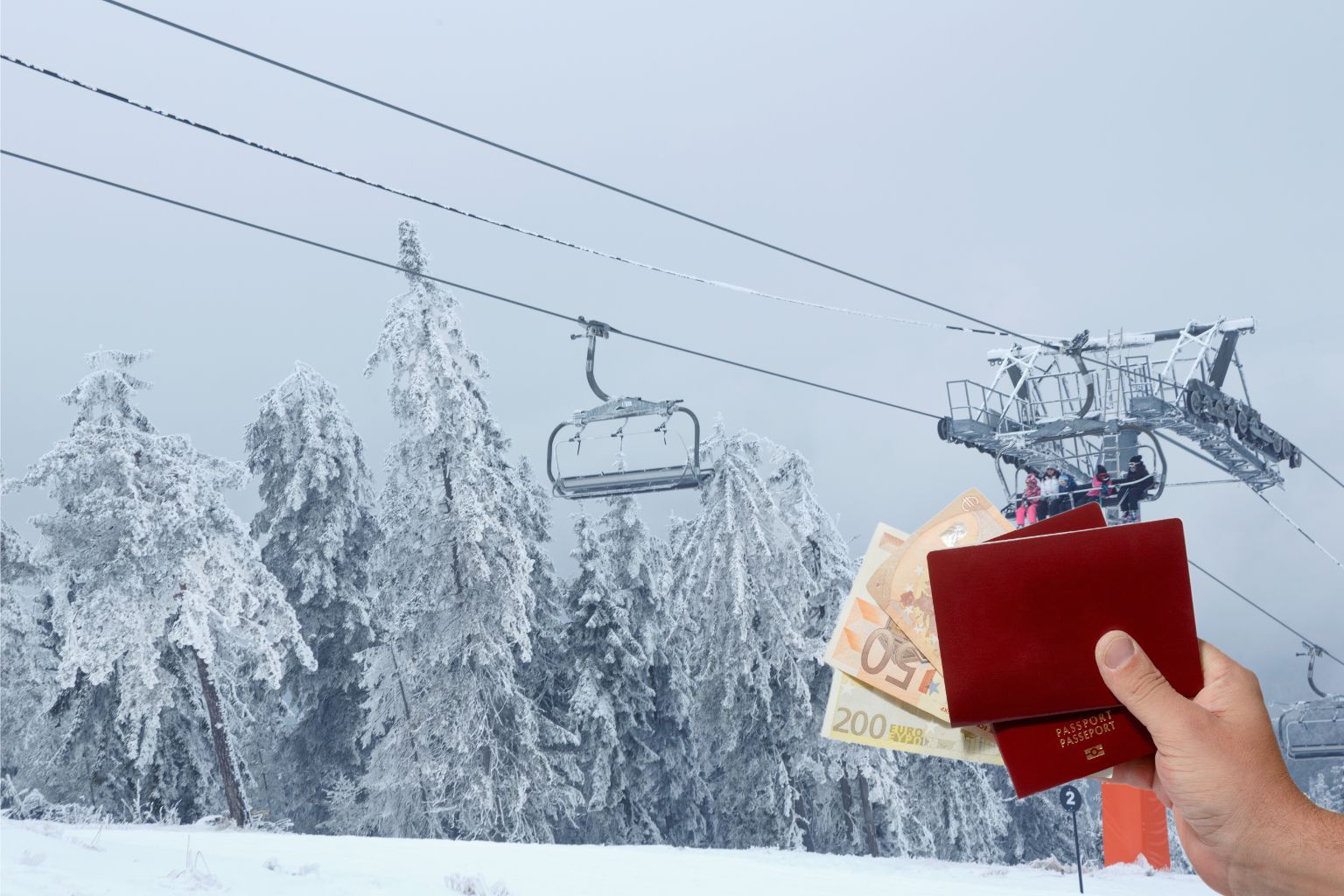
Holly Price
Apr, 19 2025- 6 mins
How to Budget for a Ski Trip: Tips to Cut Costs on Your Next Trip
We all know that skiing is not a cheap hobby. By the time you’ve equipped yourself with the basics, taken a few lessons and invested in warm, waterproof and comfortable gear, you probably won’t have much left to get you to the actual mountains. However, it’s not impossible - you can plan a ski holiday on a budget and still enjoy yourself without needing to remortgage your entire life when you get home. From choosing affordable ski resorts to our intel on how to save money while you’re out there, these are our tips to help you ski champagne powder on a beer budget!

Choosing a budget-friendly ski resort
First up for a budget ski trip is an obvious tip that you’ve likely already considered — choose a budget-friendly ski resort. With some of the big-name resorts becoming more expensive and lift pass prices being hiked up year after year, you might prefer to score some low-cost skiing in off-the-beaten-track or hidden gem resorts where you get more bang for your buck.
A similar hack is to look at the larger ski areas but opt for the lesser-known resorts within these areas. Where that ski area straddles a country border (i.e. Italy and Switzerland,) you can also choose to stay in the cheaper country - no prizes for guessing which is cheaper out of those two.
Another factor to consider when choosing your ski resort is how you’re getting there. Sometimes, flights and transfers push the overall cost of your holiday into the stratosphere, and it might work out cheaper to drive, especially if you’re splitting the fuel bill between mates. In Europe, driving in France can be pricey in terms of tolls (and you’ll pay around €50 for the Swiss vignette, which covers you for a year) so make sure to factor that into your planning.
Want the low-down on the most affordable ski resorts around the world? Head straight to the Snomad ‘Best Value’ ranking table.
Choose your dates carefully
Timing is everything when it comes to low-cost skiing, which is why you should choose your dates carefully. For example, an apartment during New Year's week can easily cost triple what it costs for a week in early April. You should weigh up peak season vs off-peak costs to see if you can save money that way. If you’re worried about the quality of the snow, opting for a higher resort or one that has access to a glacier is your best bet, but ultimately, the snowfall is out of anyone’s control.
If you’re the ultra-organised type, booking early is often advantageous for things like flight prices and a wide choice of accommodation. If it’s less about low-cost and more about spreading the cost, catered chalet companies often offer low booking deposits, allowing you to secure your place in a seriously sweet chalet while giving you plenty of time to spread the cost out throughout the year.
On the flip side of that, if you can hold out until a matter of days before you want to go, you’ll often score deals on last-minute packages where airlines and holiday providers slash prices in the hope of reaching capacity. A few years back, I kept a week in January blocked out for a ski trip and got a last-minute deal to Meribel five days before my departure date - it helps to sign up to email newsletters and keep your eyes peeled on socials for special offers.
Ultimately, here are our hot takes on how choosing the right dates can save you money on a ski trip:
- AVOID school holidays - make sure to check when the holidays are in your destination country too.
- AVOID Christmas & New Year week - prices are ramped up during this period and the slopes are often carnage anyway.
- CONSIDER an end-of-season trip. Some of my best weeks have been spent slashing the slush in late April in Tignes, and rounding off a day's shredding with some sunbathing in Andorra in late March.
- CONSIDER keeping a week free and securing a last-minute deal. Look to email newsletters and social media for exclusive offers.
- CONSIDER booking early to take advantage of earlybird offers or if you just want plenty of time to pay it all off.
- CONSIDER a shorter, mid-week break with an alternative transfer day. By ‘transfer day’ I mean that most package holidays run Saturday to Saturday or Sunday to Sunday - if you can swap this out for a midweek departure, you’ll likely find a cheaper deal.
Breakdown of main costs
Perhaps the biggest part of knowing how to budget for a ski trip is just having a rough idea of the main costs. When you’ve not been on a ski trip before, it can be quite mindblowing to discover that just getting access onto the lifts every day can set you back €400 for the week. With that in mind, the main costs of any ski trip are:
Travel
As part of the travel costs of any ski trip, you’ll need to factor in flights and transfers, unless you’re driving yourself out there. It seems the days of cheap flights are behind us, but you can still score last-minute seats or get the train instead. Many resorts often offer incentives lf you travel by train - like the free funicular from Bourg St Maurice to Les Arcs 1600.
Accommodation
From shoebox seasonnaire apartments to sprawling chalets, accommodation is pretty varied in most ski resorts, meaning you can usually suit it to your budget. Self-catering will always be cheaper, and you can get some decent prices at the end of the season.
Ski hire
Ski hire packages will vary based on the standard of equipment you want to take out, but you can expect to pay between £100 - £200 for the week. If you have your own boots or helmet, your price will be lower (and IMO, boots and helmet are a worthwhile investment, even for your first trip.)
Your absolute priority should be making sure your gear doesn’t get stolen or mistaken for someone else's, as you’ll have to pay a fee at the ski hire shop if you go back empty-handed. Invest in a portable lock, central-based locker hire or even better, take your gear back to your accommodation before you get too wavy at après.
Ski gear
This is where the big bucks come in. A decent jacket alone can set you back £200 at the absolute minimum, which is why you’ll want to be savvy when shopping for gear - more on that below.
Lift pass
The average adult week lift pass cost in Europe is between €295 to €400. In America, you can expect to pay anything between $700 and $2000 for a week’s ski ticket. Do with that information what you will.
Eating out
Eating out is another substantial cost in any ski resort, anywhere in the world. For perspective, I stayed in a catered chalet in Val Thorens over New Year week, where you get breakfast, afternoon tea and a three-course evening meal included, and I somehow still spent €750 on lunches and drinks.
Drinks
If you’re a big fan of hitting the après hard with shots, bottles and cocktails galore, your wallet is going to suffer. However, this can depend massively on the resort you choose - drinks will often be cheaper in the lesser-known spots.
Hidden ski holiday costs to watch out for
If it’s your first trip, or even your third, there will likely be things you have forgotten to include in your ski trip budget so far. This includes equipment insurance, winter sports personal insurance, local tourist taxes, parking costs at the resort and any currency exchange or ATM fees you might encounter. A lot of ATMS in Europe charge you for withdrawals, so make sure you have a card that bars will accept or pull your cash out in advance.
Money-Saving Tips
While ski holidays may be expensive, there are lots of ways you can keep the costs down if you get creative and organized enough. In summary, here are our key tips:
- Look for package deals and ski bundles - either book months in advance or days before your departure for the best deals.
- Check directly with the in-resort lift provider for discount lift passes such as student, family or group offers. Also, if you’re a beginner visiting a large ski area, check out the price difference between the local mountain and the wider area. If there’s a big price difference, it might be better for you to just stick with the local mountain.
- Loyalty programs or season passes can often work out more cost-efficient, especially if you’re based in the US and travel to the local hill regularly.
- Buying second-hand gear will save you lots of money. Apps like Vinted are chock-full of decent gear, and it’s better for the planet, too. Win-win.
- There are loads of ways to save on food. Shop in the supermarket and make your own snacks for the lift (charcuter-ski, anyone?) along with cooking dinner for yourself in self-catered accommodation.
- If travelling with your mates, you can use budgeting and cost-splitting tools such as Splitwise so that everyone knows what they need to contribute. There’s nothing worse than having to ask your mates for money or sitting there with your receipt and the calculator app.
- Setting a daily spend limit might sound obvious, but sticking to it will make all the difference between starving at the end of the week or not. Getting carried away and blowing the budget on your first afternoon? We’ve all been there.
How to budget for your ski trip: once you know, you know.
In summary, there are lots of less-obvious hacks, tips and tricks that will allow you to plan and enjoy an affordable ski trip. From browsing the Snomad league tables to discover the best value ski resort, to hopping in a car with 3 mates and splitting the cost. After all, the mountains are for everyone.







